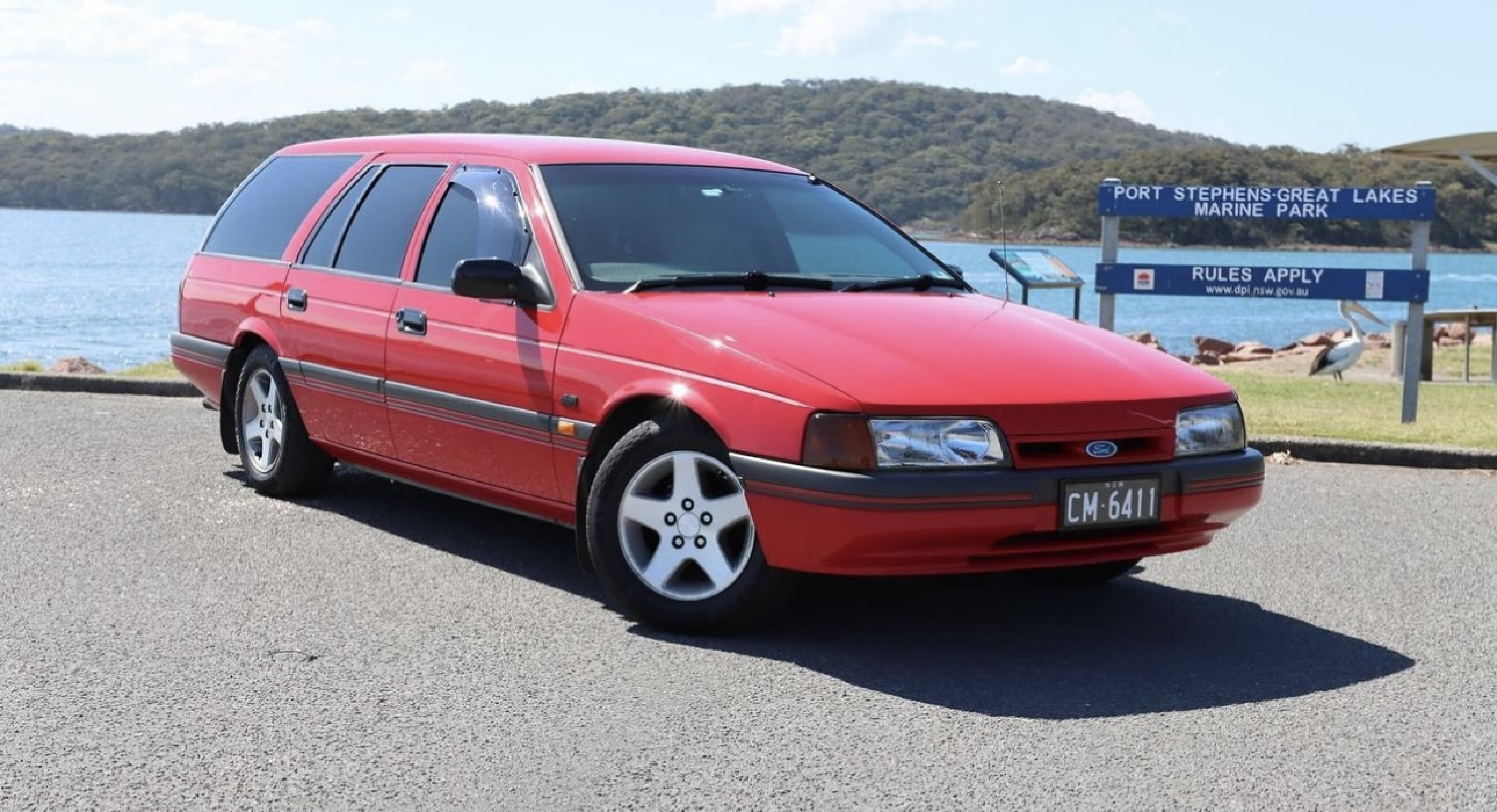
JUMP AHEAD
- What the hell was I thinking?
- The modifications begin
- Inside the Falcon
- How does it drive?
- Does the growing list of parts and repairs ever end?
- The good
- The bad
- What’s next for my wagon?
What the hell was I thinking?
In January 2020, I was looking for an affordable and interesting daily driver. Growing up in a family of adored 1990s Toyotas with exceptional reliability, I was keen to experience a homegrown product.
After stumbling across a cheap 1992 EB II GLi wagon in Le Mans Red with the rare 'Centafold' front bench seat and column automatic option – and seeing as I missed out on my neighbour’s very similar EB II a few years prior – I had to take this opportunity.
The car was in Victoria – bearing the original Garden State plates (FAA-660) – so I had a friend down in Melbourne check it out for me. It seemed reasonable, so a few days later the Falcon had made its way to Sydney on a tilt tray (during a hailstorm of course). Thankfully, the Falcon somehow survived unscathed.
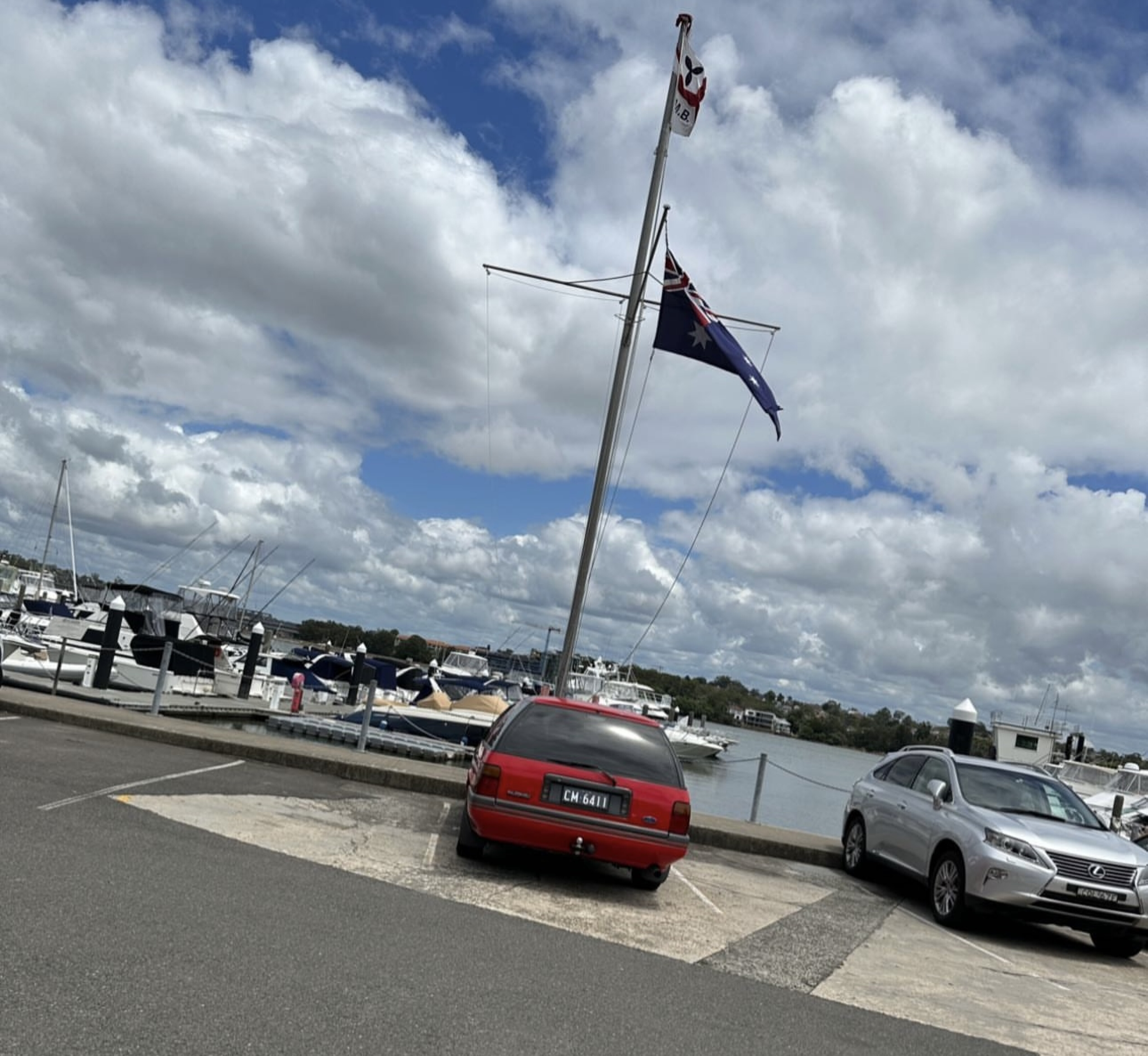
It was finally registered and ready for daily use
Over the next few weeks, with the help of a mate, the car was thoroughly cleaned inside and out. A mystery ant nest in the glovebox was found, a period correct Pioneer head unit was installed, some new rubber was fitted to the skinny 14-inch steel wheels, a general service was done, and the rotten exhaust had removed itself (it fell off on the first drive) so was replaced.
The Falcon went off for registration inspection, which required ball joints (no surprise if you are familiar with these cars), suspension components and a few minor service items. No big deal. It was finally registered and ready for daily use wearing my white-on-black CM-6411 plates.

Then it happened: the realities of waking a car from sitting dormant. The classic head gasket issue of early E-Series Falcons made itself known, with a lovely fluorescent green waterfall down the side of my engine block. My wallet said “ouch”.
Next, the automatic transmission snapped a pressure control spring and I was suddenly friendly with my local automatic transmission specialist. This, among the many other common issues such as perished hoses, gaskets, water leaks, seized brake calipers, cranky air-conditioning components and other random aged components reared their ugly heads.
All in good fun, I fixed those over time, much to the further dismay of my wallet. That said, in credit to Bosch Australia my original SmartLock immobiliser module (another common failure point) is still working perfectly.
The modifications begin
After slumming around in a povvo-pack GLi for a month, lots of switch blanks and optional extras were calling my name.
Before too long, a set of 15-inch S XR6 machine-finished alloy wheels with 205/65R15 tyres went on, a sports dash with full instrumentation appeared (built from three separate clusters), as did a clock, electric antenna, and red XR6 exterior trim inserts.
Plenty of parts were sourced from many visits to the now-departed Pick ‘n’ Payless self-serve wreckers, which always turned into an entertaining outing with my mates.

Body-wise, the original bonnet, both bumpers and the left front guard had some damage
After realising the stock brake setup wasn’t terrific, a dual-diaphragm brake booster from a former unmarked police car, DBA T2 rotors, braided lines and performance pads found themselves fitted to the car.
It had the desired effect, shortening the pedal travel and pulling this 1500-and-something kilo slab to a stop in a much-improved distance.
Body-wise, the original bonnet, both bumpers and the left front guard had some damage from a minor incident prior to my ownership, so were replaced and resprayed. Most of the original Le Mans Red acrylic lacquer remains elsewhere, in reasonably good condition.

Inside the Falcon
The interior of the Falcon is a sea of many different shades of grey cloth and plastic, although being an EB II, my example has the two-tone dash (dark grey upper section, light grey lower section) which makes the car feel a little less like sitting within an elephant that’s been turned inside out.
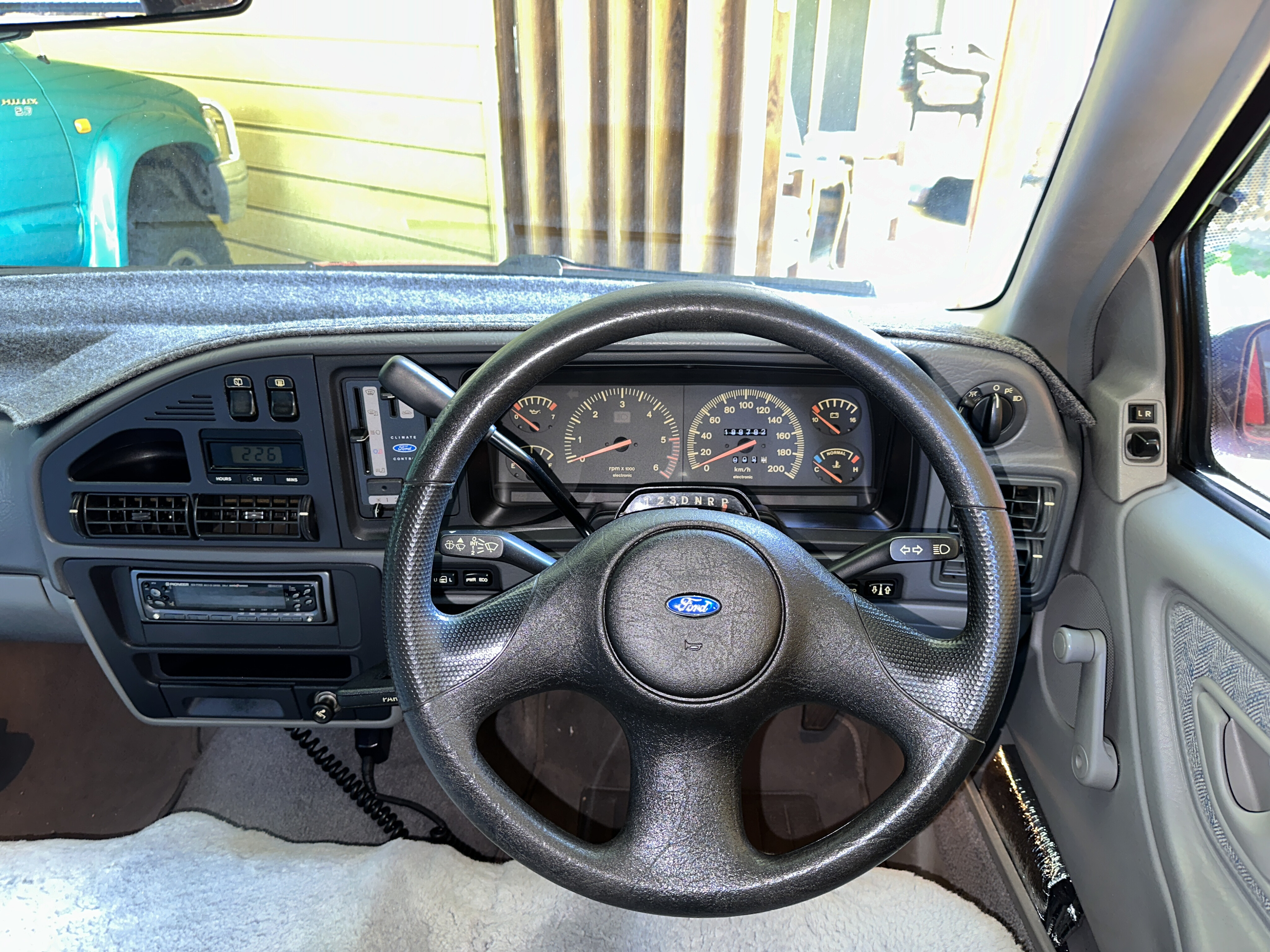
Next to the clock is a strangely shaped compartment originally designed for taxi drivers to store their business cards
A very comfortable front bench seat is found up front, with a centre folding armrest that becomes a third seat – a feature for which Ford coined the term 'Centafold'.
The creature comforts are present, with manual 'Ford Climate Control' sliders and switches unconventionally placed next to the cluster for efficient and non-distracting fingertip operation that soon becomes muscle memory.
By contrast, the rear demister and wiper rocker switches are questionably mounted off to the left and above the clock, feeling like a bit of an afterthought.

Next to the clock is a strangely shaped compartment originally designed for taxi drivers to store their business cards. Anything placed inside will fly out at any given moment, so it is quite useless.
Apart from the headlight and dome light controls being placed on the dash, common for Australian cars at the time, the usual stalk-mounted indicator, high beam and wiper controls are present.
Located above the driver’s knees are controls for the tailgate, central locking, power/economy transmission modes and (dealer optional) electric antenna, as well as the handbrake (taken from the XD Falcon).
These are often obscured by the large steering wheel, projected at the driver at an angle as the steering column is off-centre and skewed slightly to the right, much like some Holden Torana models in the past.

In the lower dash are a single DIN radio aperture, a vacant slot for a small tissue box (or 1990s graphic equaliser) and the telltale 1990s feature, an ashtray.
There’s another three-seater bench at the rear, which is a great place to fall asleep during a road trip (hopefully not from carbon monoxide leaking through the tailgate seal).
As well as window winders, ashtrays are mounted to the doors (presumably so 90s kids could smoke too). Apart from that, there’s absolutely nothing else back there. Purposeful and dedicated (read: povvo pack).

The rear seat backrests have a 60:40 split-folding configuration to yield even more cargo room from an already cavernous cargo area.
Said cargo area has an interior light, a small storage cubby for tools, and a compressed timber floor panel under the carpet, which conceals the 72-litre fuel tank, a handful of spare items and a full-sized spare tyre (try that with your modern car!).
The cargo area has a flat floor, with a wide and low opening aperture, making for a practical classic.
How does it drive?
The MPFI 4.0-litre SOHC engine – with however many of the original 148kW and 348Nm left – is a lazy, torquey, low-revving cruiser most of the time but can be strung out to around the 5000rpm range, clutch fan roaring, ready for a red light drag race. Theoretically speaking.
At high revs, the crank feels like it wants to eject from the block, with a definitive angry note emanating from the engine bay. Ford did eventually sort this out with the addition of more main bearings and better balancing in the infamous Intech.
With a four-speed BTR slushbox and its classic first-gear taxi whine, the gears are quite tall in this car, making for a sluggish start off the line but great cruising legs on the highway (within the legal speed limit, of course).
The engine and transmission combo feels industrial and heavy-duty, inspiring a feeling of confidence and heft that is seldom felt in modern drivetrains. Fuel consumption sits around a reasonable 9.0L/100km on the highway, or a thirsty 14L/100km when driven mercilessly. Nowhere near the economy of a new car, but that’s not a surprise.
For something resembling a brick, my Falcon handles surprisingly reasonably, with a firm but comfortable ride. In stock form, however, the suspension felt much like a soggy old mattress and not engaging whatsoever.
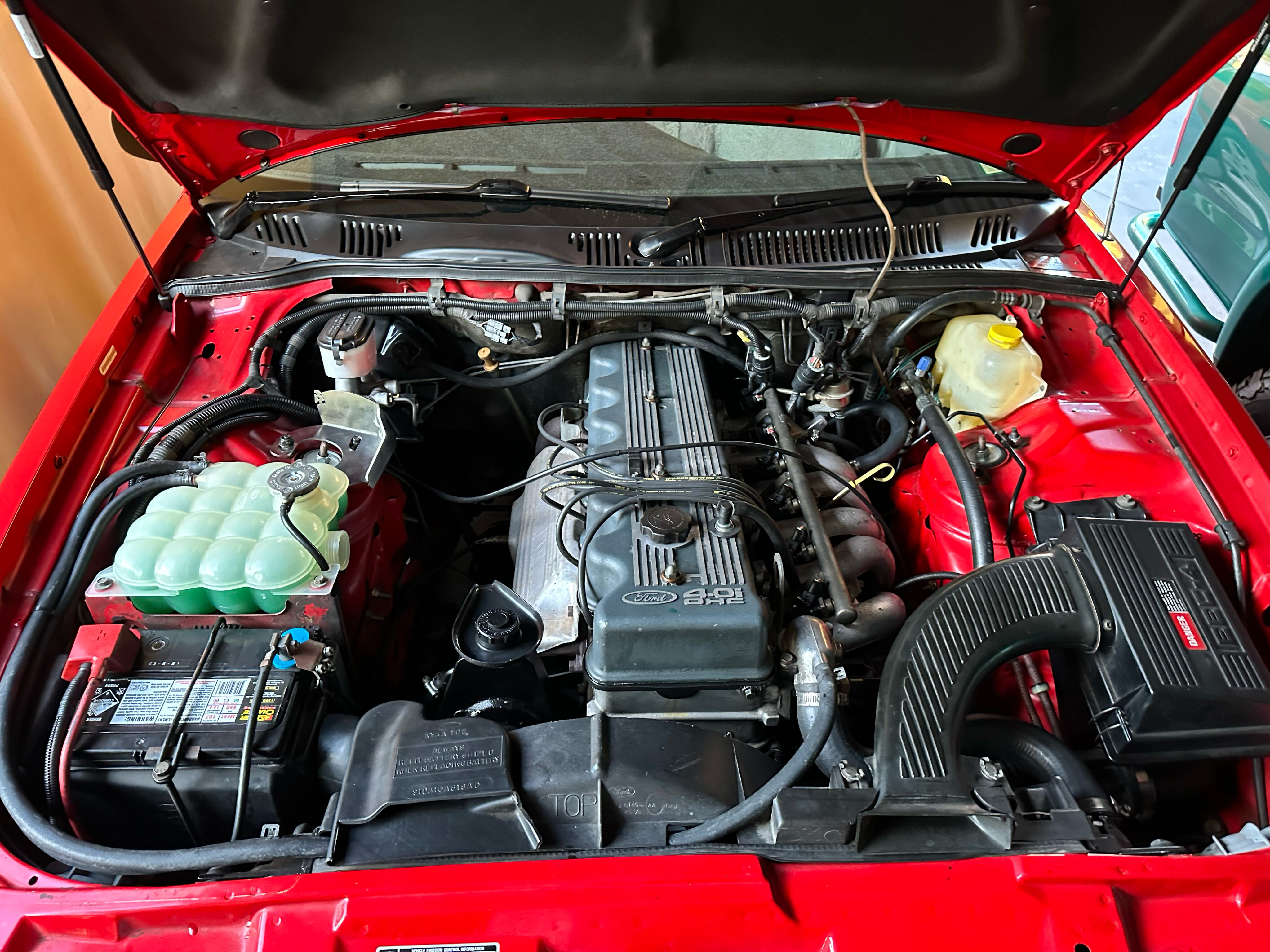
With a front-end alignment, new suspension all round, a larger front sway bar and the addition of a rear sway bar, the live-axle, leaf-sprung commercial rear end became a joy to flick around, especially in the wet.
After the underwhelming original open diff centre experienced sudden and unscheduled disassembly in a local industrial estate (on a late and rainy night, naturally) I fitted an Eaton Truetrac LSD that made a night-and-day difference in terms of predictability and control.
Steering feel through the Kirby-Bishop hydraulic power rack and pinion setup is direct with great feedback and not overly insulated, unlike GM Holden’s offerings at the time.
Although a little front-heavy with the inline six-cylinder lump up front, the SLALS pseudo-double-wishbone front end (inspired by those Euro traitors) still holds up, even in the corners of a particular national park found south of Sydney.
The complete lack of anything resembling ABS or traction control makes for a direct and focused driving experience compared with modern cars.
Surprisingly, even in a torrential downpour, it takes a lot to upset the Falcon’s stability; solid and confident roadholding on 205/65R15s was not what I had initially expected.
The original 195/75R14 cheese-cutters were far less confidence-inspiring, although for a long-wheelbase car of considerable weight (for its time) the Falcon is fairly nimble.

Does the growing list of parts and repairs ever end?
Eventually, it does. After sorting out all the essential safety and roadworthy items, and replacing ageing sensors and electrical components (looking at you, TFI module and Loch Ness distributor, buried below the intake manifold) it mostly comes down to cosmetic wear and tear.
It all boils down to one point – accepting imperfection. When a car reaches a certain age some non-essential wear-related items will appear. Even as a chronic perfectionist who is never truly satisfied, I know it’s best to think of these blemishes as part of the car’s history; a tapestry of its life.
Enjoying the vehicle for what it is and using it as it was designed for are the most important things to value and remember. Otherwise, you’ll end up chasing your tail.
In the case of my Falcon, it is a daily driver, to preserve my other cars. One of them has to cop some wear and the wagon takes it in its stride.
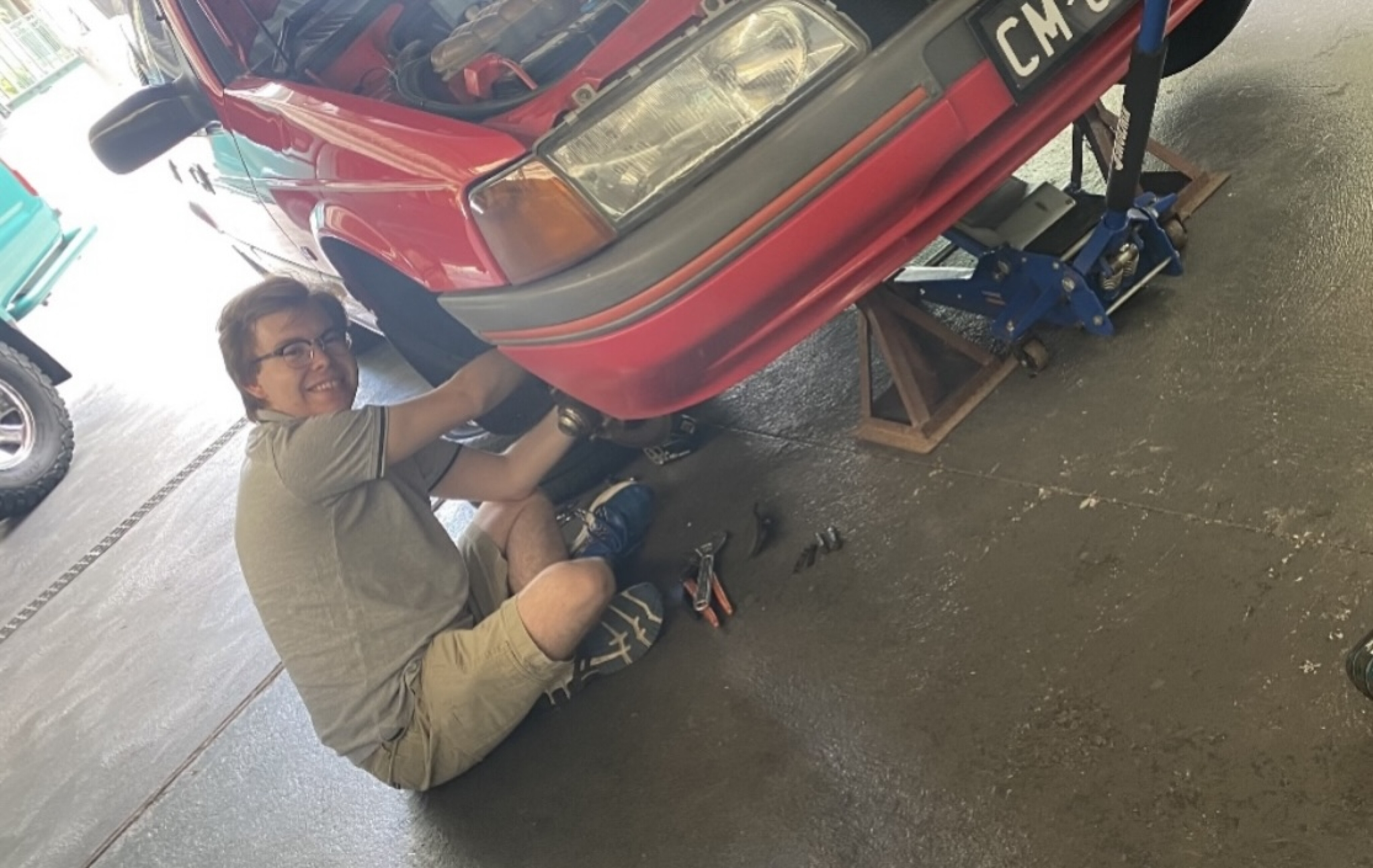
The Good
The Falcon is a properly sized station wagon, a body shape nearly extinct now.
The cargo capacity is exceptionally cavernous and extremely practical. I’ve driven my elderly German Shepherd around, saved vintage things in council clean-ups, and have used the cargo area to hold many late-night McDonalds “tailgate conferences” with mates, using the open tailgate as a rain shelter. It’s almost like Ford designed the wagon for these purposes…
For its age, the Falcon is pretty easy to live with.
It keeps up relatively well in modern traffic, with enough overtaking power for highway driving. The air-conditioning is freezing cold in summer and the heater is painfully hot in winter.
The Falcon provides an unhindered and unassisted direct driving experience, in a modern-enough car to live with daily.
No reversing camera or sensors needed, just turn your head and look for yourself, out of the generously sized rear glass.
Attention. Lots of people will notice the car and quite a few will share a memory or two.
Particularly entertaining is local highway patrol officers sharing stories of their EB Falcons with me and asking to check out my car. I now receive a wave in traffic from various local police cars, which keeps things interesting!
Collective fun.
My wagon has brought many of my mates together for various missions and drives in my time of ownership, with the freedom to fit five friends comfortably – you can’t do that in an MR2 or MX-5!

The Bad
Parts availability.
E-Series Falcons are fitted with many interchangeable parts, some from American Fords of the era and some from earlier (and later) Australian Fords, which can still be found.
However, many parts are specific to the exact generation of Falcon so with age, rarity and discontinued genuine or quality parts, specific components such as the ignition distributor, central locking actuators, blower motors, air-conditioning compressor and various body and trim components can prove very difficult or impossible to source and are often quite expensive.
Aftermarket support is nowhere near comparable to GM Holden or European cars of the same era.
E-Series Falcons rely on specific service requirements and uncommon fluids, such as MobilFluid 454 for the power steering, which can only be found at a random selection of 7-Eleven servos, or the wind-back rear brake calipers that are often destroyed by unwary owners with g-clamps.
Owning a factory service manual is essential as these cars are as fussy as a BMW or Benz of the same era and any neglect of these requirements will lead to failure down the track.
Old gaskets and seals can also be a pain and require labour-intensive disassembly and reassembly.
There are a few oil leaks that I tolerate due to the immense work involved in rectifying them. I prefer to think of it as active corrosion protection.
In terms of cosmetics – four words. Single stage red paint.
Keeping the Falcon shiny and red is a task, requiring frequent machine polishing and lots of waxing, and there’s lots of real estate to cover.
These points considered, if a breakdown occurs the Falcon can end up off the road for a few weeks while waiting for parts. Unless someone keeps a hoard of spares in their wardrobe like I do.
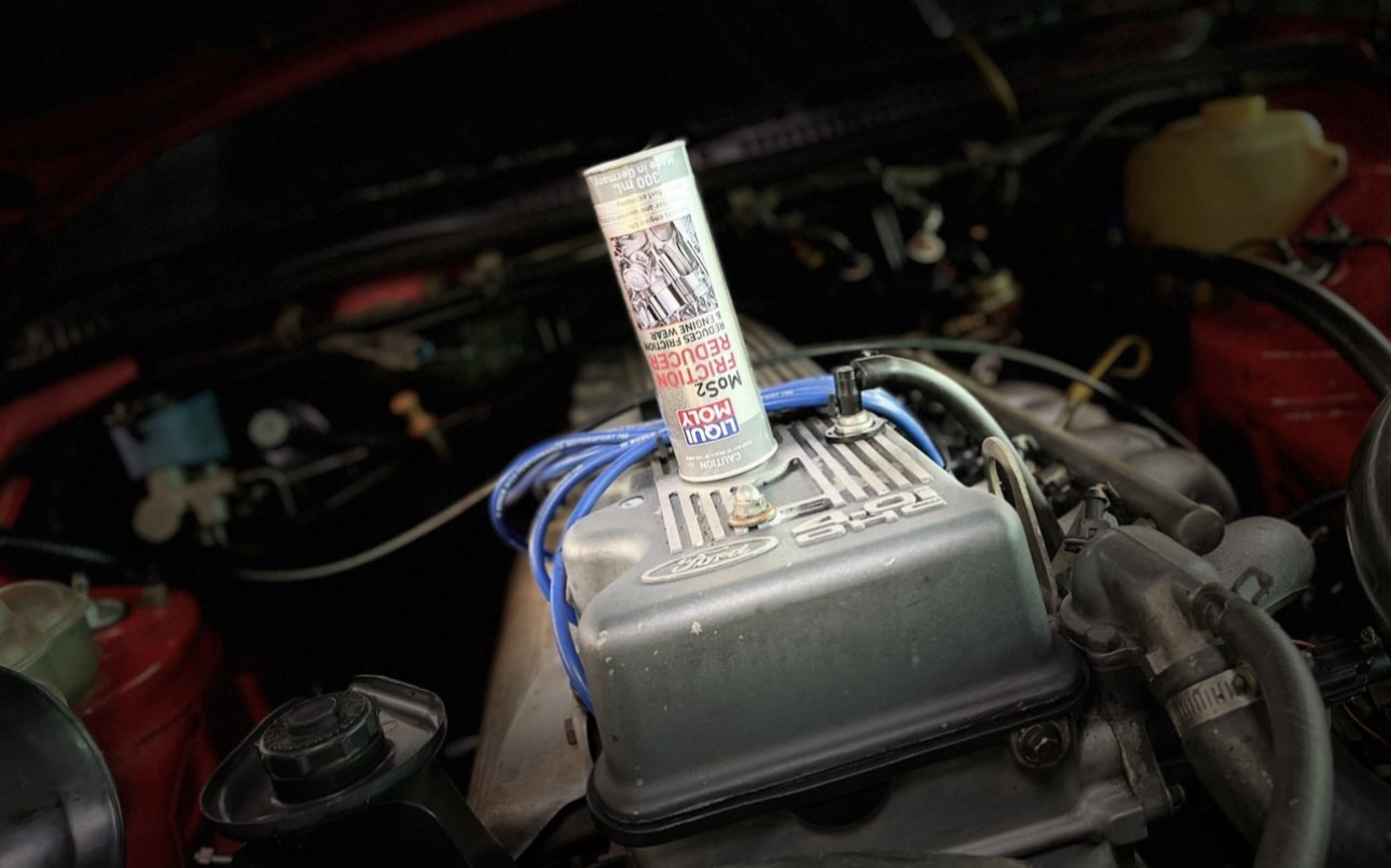
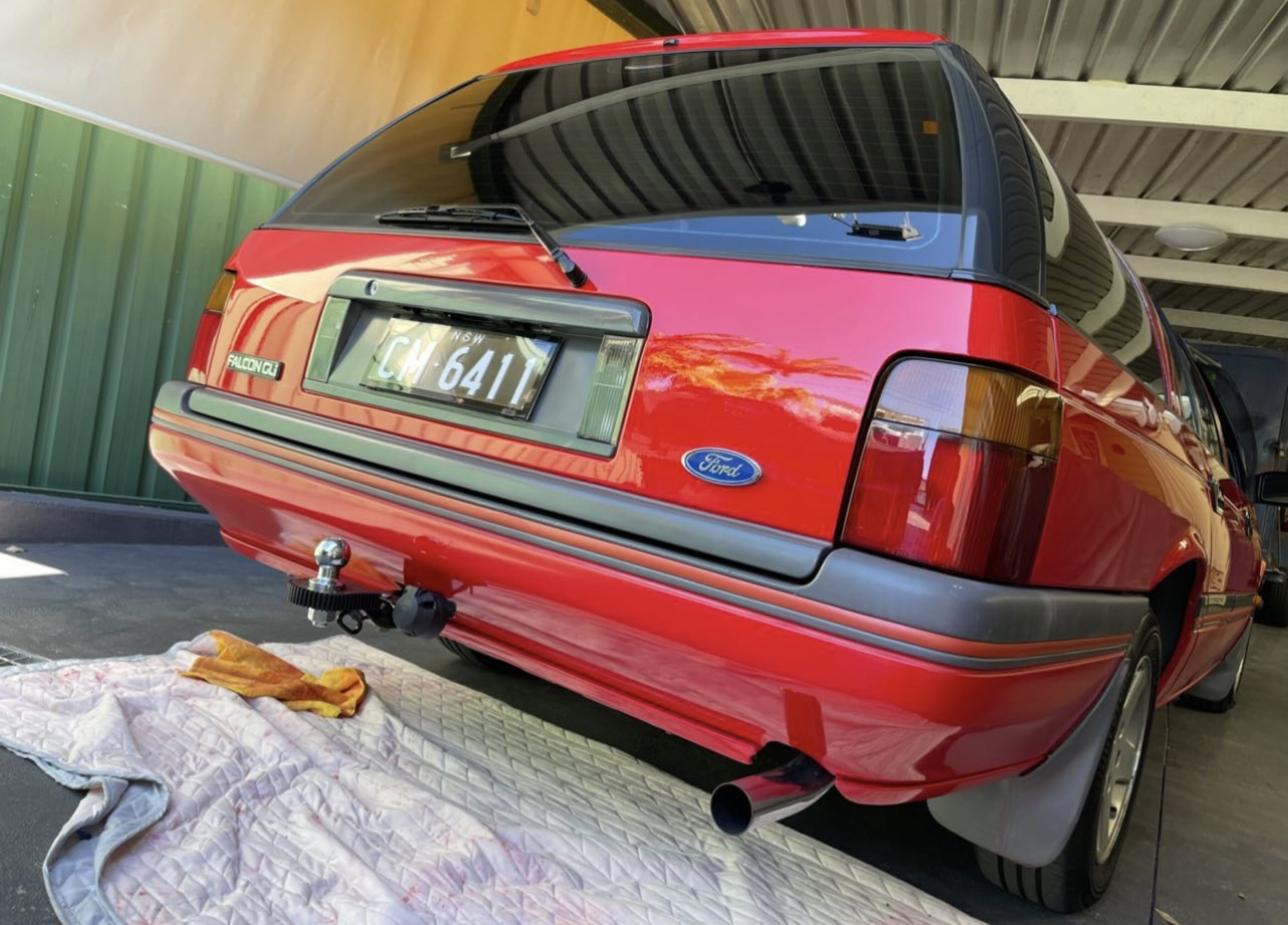
What’s next for my wagon?
During my ownership, I have essentially replaced every mechanical component except the bottom end of the engine, with upgrades that will support some forced induction in the future.
It would be quite nice to bolt a sneaky turbo onto the SOHC, keeping the interior and exterior as unassuming as possible. I have no idea when this will happen but it’s a nice pipe dream.
When it comes to good rubber, 205/65R15 tyres are proving increasingly uncommon as time goes on and are mainly designed for smaller modern cars. As such, some BFGoodrich Radials in 225/60R15 size will be fitted next, for some extra roadholding ability (white letters on the inside of course).
Oh, and some Koni Red shock absorbers wouldn’t go astray…
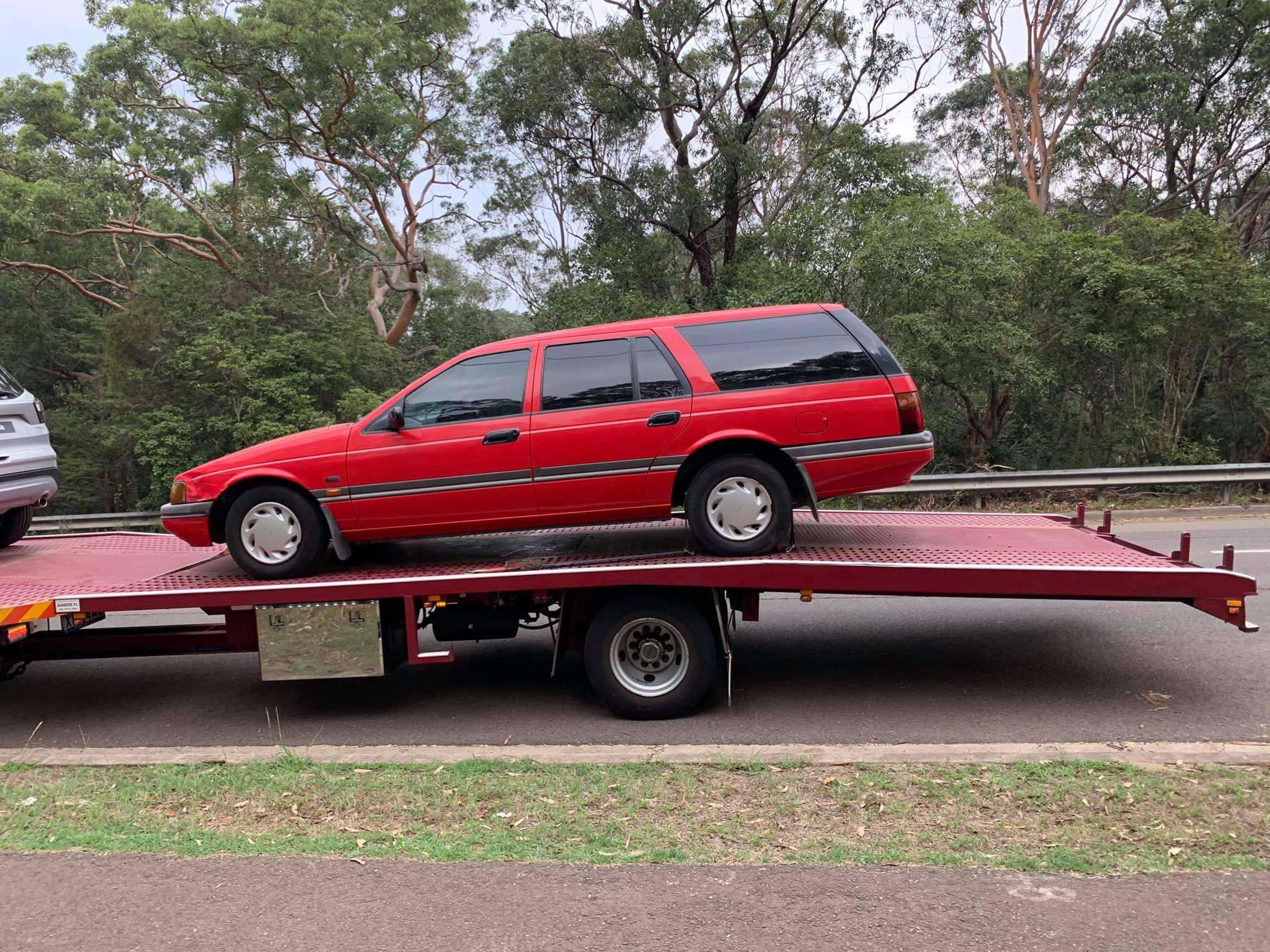
COMMENTS